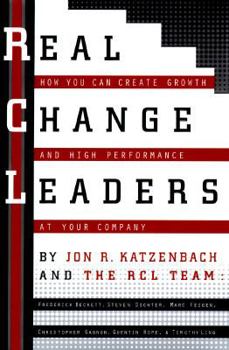Real Change Leaders: How You Can Create Growth and High Performance at Your Company
Select Format
Select Condition 
Book Overview
Jon Katzenbach of McKinsey & Company shows readers how solutions to today's most vexing business problem--fast-paced, unrelenting change--lie with a new breed of leaders emerging at the middle levels... This description may be from another edition of this product.
Format:Hardcover
Language:English
ISBN:0812926269
ISBN13:9780812926262
Release Date:December 1995
Publisher:Crown Business
Length:357 Pages
Weight:1.45 lbs.
Dimensions:1.3" x 6.5" x 9.6"
Customer Reviews
2 ratings
Invaluable Guidance to Prudent Growth and Real Achievement
Published by Thriftbooks.com User , 24 years ago
There are several reasons why I think this is one of the most important business books I have read in recent years. Here are three. First, it is the best single-source I have as yet encountered which prescribes and explains a cohesive program by which create growth and high performance in an organization. Also, this program allows for all manner of adjustments and modifications to accommodate the specific, sometimes unique needs and interests of any organization. Finally, it is extraordinarily well-written. In fact, this edition combines two books in one volume because the original version has since been expanded to include "The RCL's Handbook for Action." To gather the information they needed, Katzenbach and his associates at McKinsey & Company (the "RCL Team") examined more than 30 different change situations and interviewed more than 150 change leaders. In the Introduction, they discuss seven common characteristics among the RCLs and then cite three shared beliefs:1. "Tough standards of performance, but not just financial performance; customer value and workforce rewards are important as well.2. "A set of democratic principles that tap the creative power inherent in every person; but they also enforce consequence management, believing they can truly empower people only by requiring results in return.3. "The essence of self-governance is joint accountability (among leaders and constituents alike) for creating new opportunity; the basic approach is open dialogue and interaction to resolve conflicts by working to obtain the best contributions from multiple points of view."The material is organized within three Parts: People-Intensive Change, Engaging the Organization, and Leadership Capacity and Growth. Throughout the book, the reader is provided with immensely informative as well as convenient charts (eg "Differences Between `Good Managers' and RCLs) which feature key points. I have already noted "The Real Change Leader's Handbook for Action" (pages 341-391 in the softbound edition) which, in effect, gives each reader a template as well as a frame-of-reference to implement whichever combination of concepts, strategics, and tactics is most appropriate. The "Handbook" offers comments, suggestions, checklists and frameworks "for getting started in areas where change leadership help is needed."For me, one of the book's greatest values is derived from its response to the question, "What distinguishes a real change leader from traditional managers?" The answer may in some ways surprise you, as it did me. For example, "Real change leaders do not care if the change effort is fast or slow, empowered or controlled, one-time or recurring, cultural or engineered -- or all of the above. They only care that it is people-intensive, and performance oriented....Simply put, real change leaders learn how to survive and win in the delta state, while traditional managers can only survive in the current state or the future state." The real change leader
Very good book - down to earth examples
Published by Thriftbooks.com User , 26 years ago
This is a very good book about the practical issues of Change Management. You should read it together with Smith's "Taking Charge of Change". These two books will give you advise about the "how to" side of Change Management. Highly recommended.





